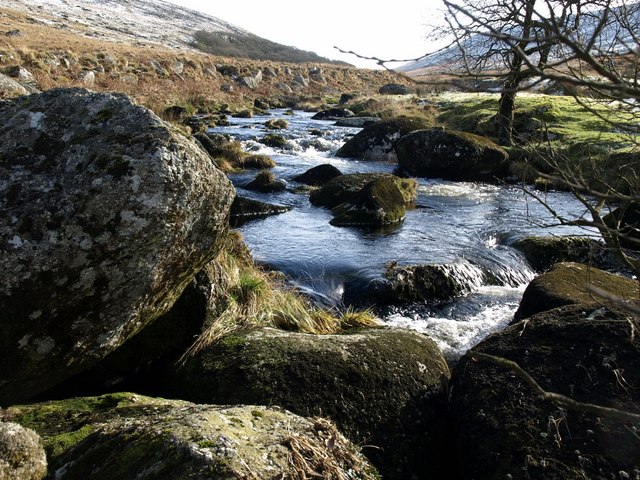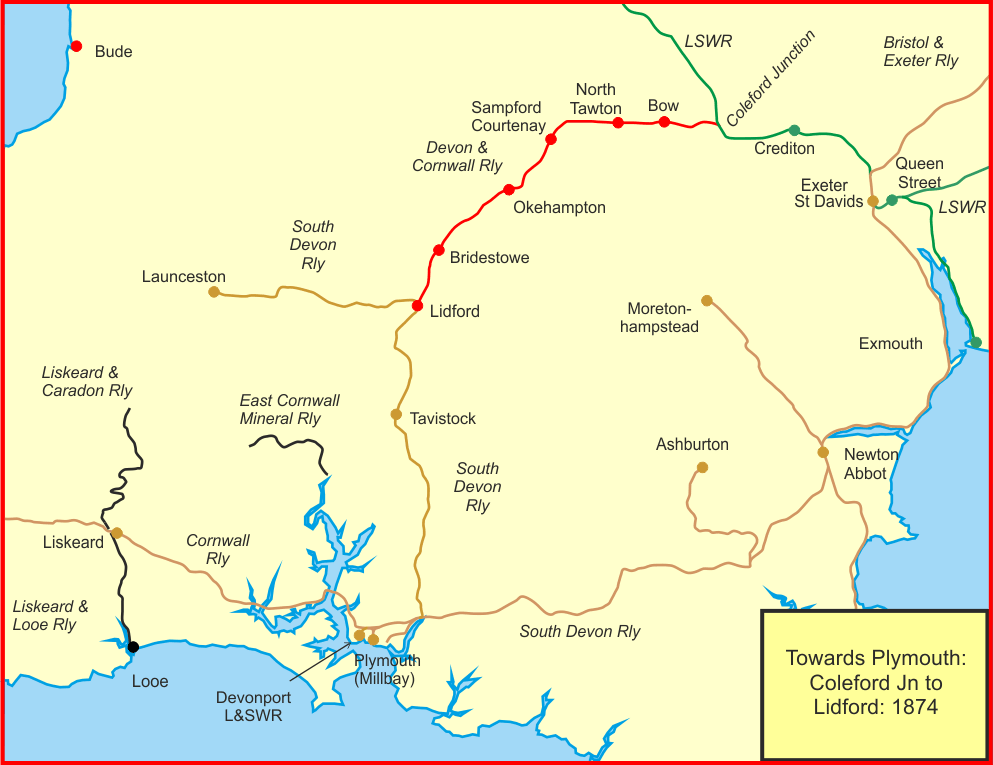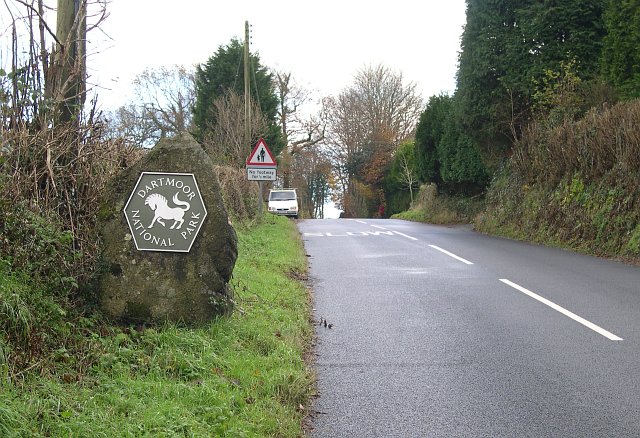|
Meldon Viaduct
Meldon Viaduct carried the London & South Western Railway (LSWR) across the West Okement River at Meldon (near Okehampton) on Dartmoor in Devon, South West England. The truss bridge, which was constructed from wrought iron and cast iron not stone or brick arches, was built under the direction of the LSWR's chief engineer, WR Galbraith. After taking three years to build, the dual-tracked bridge opened to rail traffic in 1874. Usage was limited to certain classes of locomotive because the viaduct had an axle load limit. Although regular services were withdrawn in 1968, the bridge was used for shunting by a local quarry. In the 1990s the remaining single line was removed after the viaduct was deemed to be too weak to carry rail traffic. The crossing is now used by The Granite Way, a long-distance cycle track across Dartmoor. The viaduct, which is a scheduled monument, is now one of only two such surviving railway bridges in the United Kingdom that uses wrought iron lattice piers ... [...More Info...] [...Related Items...] OR: [Wikipedia] [Google] [Baidu] |
West Okement River
The West Okement is a river in north Dartmoor in Devon in south-west England. It rises at West Okement Head near Cranmere Pool and flows in a generally NW direction past Black-a-Tor Copse and into Meldon Reservoir. After exiting the reservoir it flows in a generally northeast direction towards Okehampton, where it joins the East Okement River to form the River Okement The River Okement is a tributary of the River Torridge in Devon, England. It used to be known as the River Ock. It rises at two places in Dartmoor, as the West Okement and the East Okement. These meet with other minor streams and join togethe .... Its total length is roughly . Okement Okement 2WestOkement {{England-river-stub ... [...More Info...] [...Related Items...] OR: [Wikipedia] [Google] [Baidu] |
Great Western Railway
The Great Western Railway (GWR) was a British railway company that linked London with the southwest, west and West Midlands of England and most of Wales. It was founded in 1833, received its enabling Act of Parliament on 31 August 1835 and ran its first trains in 1838 with the initial route completed between London and Bristol in 1841. It was engineered by Isambard Kingdom Brunel, who chose a broad gauge of —later slightly widened to —but, from 1854, a series of amalgamations saw it also operate standard-gauge trains; the last broad-gauge services were operated in 1892. The GWR was the only company to keep its identity through the Railways Act 1921, which amalgamated it with the remaining independent railways within its territory, and it was finally merged at the end of 1947 when it was nationalised and became the Western Region of British Railways. The GWR was called by some "God's Wonderful Railway" and by others the "Great Way Round" but it was famed as the "Holiday ... [...More Info...] [...Related Items...] OR: [Wikipedia] [Google] [Baidu] |
Dawlish
Dawlish is an English seaside resort town and civil parish in Teignbridge on the south coast of Devon, from the county town of Exeter and from the larger resort of Torquay. Its 2011 population of 11,312 was estimated at 13,355 in 2019. It is to grow further as several housing estates are under construction, mainly in the north and east of the town. It had grown in the 18th century from a small fishing port into a well-known seaside resort, as had its near neighbour, Teignmouth, in the 19th century. Between Easter and October the population can swell by an additional 20,000. largely in self-accommodation, caravan, camping and holiday parks (mostly in neighbouring Dawlish Warren) Description Dawlish is located at the outlet of a small river, Dawlish Water (also called The Brook), between Permian red sandstone cliffs, and is fronted by a sandy beach with the South Devon Railway sea wall and the Riviera Line railway above. Behind this is a central public park, The Lawn, through wh ... [...More Info...] [...Related Items...] OR: [Wikipedia] [Google] [Baidu] |
Great Western Main Line
The Great Western Main Line (GWML) is a main line railway in England that runs westwards from London Paddington to . It connects to other main lines such as those from Reading to Penzance and Swindon to Swansea. Opened in 1841, it was the original route of the first Great Western Railway which was merged into the Western Region of British Railways in 1948. It is now a part of the national rail system managed by Network Rail with the majority of passenger services provided by the current Great Western Railway franchise. The line has recently been electrified along most of its length. The eastern section from Paddington to was electrified in 1998. Work to electrify the remainder of the route started in 2011 with an initial aim to complete the work all the way to Bristol by 2016, but in that year the section through Bath to Bristol Temple Meads was deferred with no date set for completion because costs had tripled. History The line was built by the Great Western Railway ... [...More Info...] [...Related Items...] OR: [Wikipedia] [Google] [Baidu] |
Winter Storms Of 2013–14 In The United Kingdom
Winter is the coldest season of the year in polar and temperate climates. It occurs after autumn and before spring. The tilt of Earth's axis causes seasons; winter occurs when a hemisphere is oriented away from the Sun. Different cultures define different dates as the start of winter, and some use a definition based on weather. When it is winter in the Northern Hemisphere, it is summer in the Southern Hemisphere, and vice versa. In many regions, winter brings snow and freezing temperatures. The moment of winter solstice is when the Sun's elevation with respect to the North or South Pole is at its most negative value; that is, the Sun is at its farthest below the horizon as measured from the pole. The day on which this occurs has the shortest day and the longest night, with day length increasing and night length decreasing as the season progresses after the solstice. The earliest sunset and latest sunrise dates outside the polar regions differ from the date of the winter s ... [...More Info...] [...Related Items...] OR: [Wikipedia] [Google] [Baidu] |
Meldon Dam
Over the course of the 19th and 20th centuries, several reservoirs and dams were built in the area now covered by Dartmoor National Park in Devon, England to supply drinking water to the rapidly growing towns in the surrounding lowlands. With its deep valleys and high rainfall, Dartmoor was an inevitable location. New reservoirs continued construction even after the establishment of the National Park in 1951. Early schemes to use the moors as a source of drinking water involved the construction of water channels called leats. For example, Drake's Leat (completed 1591) took water to Plymouth and the Devonport Leat (1793) to the docks at Devonport. Rapid population growth of the seaside communities in the late 19th century and the birth of tourism required a significant improvement in quality and quantity of fresh water. The first Dartmoor reservoir (Tottiford) opened in 1861 and heralded a busy era of dam construction which continued through to 1907, by which time the Dartmoor a ... [...More Info...] [...Related Items...] OR: [Wikipedia] [Google] [Baidu] |
Shunting (rail)
Shunting, in railway operations, is the process of sorting items of rolling stock into complete trains, or the reverse. In the United States this activity is known as switching. Motive power Motive power is normally provided by a locomotive known as a ''shunter'' (in the UK) or switcher (in the US). Most shunter/switchers are now diesel-powered but steam and even electric locomotives have been used. Where locomotives could not be used (e.g. because of weight restrictions) shunting operations have in the past been effected by horses or capstans. Hazards Coupling The terms "shunter" and "switcher" are applied not only to locomotives but to employees engaged on the ground with shunting/switching operations. The task of such personnel is particularly dangerous because not only is there the risk of being run over, but on some railway systems—particularly ones that use buffer-and-chain/screw coupling systems—the shunters have to get between the wagons/carriages in order to ... [...More Info...] [...Related Items...] OR: [Wikipedia] [Google] [Baidu] |
Derrick
A derrick is a lifting device composed at minimum of one guyed mast, as in a gin pole, which may be articulated over a load by adjusting its guys. Most derricks have at least two components, either a guyed mast or self-supporting tower, and a boom hinged at its base to provide articulation, as in a ''stiffleg'' derrick. The most basic type of derrick is controlled by three or four lines connected to the top of the mast, which allow it both to move laterally and cant up and down. To lift a load, a separate line runs up and over the mast with a hook on its free end, as with a crane. Forms of derricks are commonly found aboard ships and at docking facilities. Some large derricks are mounted on dedicated vessels, and known as floating derricks and sheerlegs. The term derrick is also applied to the framework supporting a drilling apparatus in an oil rig. The derrick derives its name from a type of gallows named after Thomas Derrick, an Elizabethan era English executioner. Types ... [...More Info...] [...Related Items...] OR: [Wikipedia] [Google] [Baidu] |
Exeter To Plymouth Railway Of The LSWR
The Exeter to Plymouth railway of the London and South Western Railway (LSWR) was the westernmost part of a route competing with that of the Great Western Railway (GWR) and its 'associated companies' from London and Exeter to Plymouth in Devon, England. Whereas the GWR route from Exeter followed the coast to Newton Abbot and then went around the southern edge of Dartmoor, the LSWR route followed the northern and western margins of Dartmoor, passing through the towns of Crediton, Okehampton, and Tavistock. The route was constructed piecemeal by independent companies, in most cases supported by the LSWR. LSWR trains first reached Plymouth in 1876 and the route took on its final form in 1891. The central part of the line closed in 1968, leaving just local services at either end. History Railways to Exeter The broad gauge Bristol and Exeter Railway (B&ER) was the first line to reach Exeter. It had reached St Davids station in Exeter in 1844 and was allied with the Great We ... [...More Info...] [...Related Items...] OR: [Wikipedia] [Google] [Baidu] |
Dartmoor National Park Authority
The Dartmoor National Park Authority (DNPA) is a national park authority in England, legally responsible for Dartmoor in Devon. It came into existence in its present form in 1997, being preceded by a committee of Devon County Council (from 1951 to March 1974) and the Dartmoor National Park Committee from 1 April 1974. History Dartmoor, in the county of Devon, is 368 square miles (954 km2) in area. It was designated as one of the National Parks of England and Wales by statute in 1951; it has over 34,000 people living in it, and some 2.2 million people visited it in 2011. First incarnation For the first 23 years of its existence, Dartmoor National Park was administered by a special committee of Devon County Council,Mercer 2009, p. 326 the "Dartmoor Sub-Committee". During this time the major proposals dealt with by the committee included extensions of china clay workings and coniferous plantations (which did not take place); the erection of a television transmitting mast at No ... [...More Info...] [...Related Items...] OR: [Wikipedia] [Google] [Baidu] |
Devon County Council
Devon County Council is the county council administering the English county of Devon. Based in the city of Exeter, the council covers the non-metropolitan county area of Devon. Members of the council (councillors) are elected every four years to represent the electorate of each county division, almost all being nominated by the major national political parties. The population of the area administered by the council was estimated at 795,286 in 2018, making it the largest local authority in South West England. Devon is an area with "two-tier" local government, meaning that the county is divided into non-metropolitan districts carrying out less strategic functions, such as taking most planning decisions. In Devon there are eight such districts, each with its own district, borough, or city council. History Administration Before 1888, the small towns and rural areas in Devon were governed by magistrates through the Devon Court of Quarter Sessions. The magistrates were based at Roug ... [...More Info...] [...Related Items...] OR: [Wikipedia] [Google] [Baidu] |
Isambard Kingdom Brunel
Isambard Kingdom Brunel (; 9 April 1806 – 15 September 1859) was a British civil engineer who is considered "one of the most ingenious and prolific figures in engineering history," "one of the 19th-century engineering giants," and "one of the greatest figures of the Industrial Revolution, hochanged the face of the English landscape with his groundbreaking designs and ingenious constructions." Brunel built dockyards, the Great Western Railway (GWR), a series of steamships including the first propeller-driven transatlantic steamship, and numerous important bridges and tunnels. His designs revolutionised public transport and modern engineering. Though Brunel's projects were not always successful, they often contained innovative solutions to long-standing engineering problems. During his career, Brunel achieved many engineering firsts, including assisting in the building of the first tunnel under a navigable river (the River Thames) and the development of the , the first ... [...More Info...] [...Related Items...] OR: [Wikipedia] [Google] [Baidu] |







.jpg)



